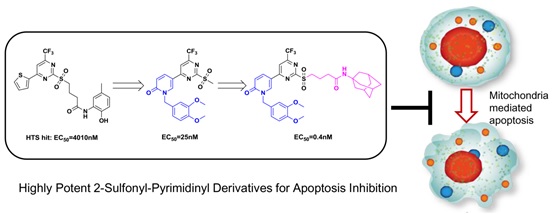Research News
Studies from Dr. Zhiyuan Zhang’s laboratory discovered a series of new and potent apoptosis inhibitors
In the current issue of ACS Medicinal Chemistry Letter available from April 14 2017, Dr. Zhiyuan Zhang and Dr. Xiaodong’s lab from NIBS collaborated in publishing a research article entitled “Discovery of Highly Potent 2-ulfonyl-Pyrimidinyl Derivatives for Apoptosis Inhibition and Ischemia Treatment”. In this article, the authors reported the discovery of a series of 2‑sulfonyl-pyrimidinyl derivatives as new and highly potent apoptosis inhibitors, and revealed the systematic structure-activity relationship study of this series of compounds. Also, the authors demonstrated the lead compound 33 and 40 of this series had obvious protective effect on the rat model of ischemia.

Pathological apoptosis is closely related to neurodegenerative disorders such as Alzheimer’s disease, Parkinson’s disease and so on, ischemic injury, immunodeficiency and many other severe diseases. So far, the existing apoptosis inhibitors include Bax inhibitors, Bid inhibitors and caspase inhibitors. However, these apoptosis inhibitors either have limited micromolar potency or induce secondary cell injury, and this current situation calls for the development of new and potent apoptosis inhibitors with great urgency. At the same time, the discovery of new and potent apoptosis inhibitors can provide powerful research tools for elucidating the biological mechanism of apoptosis.
After cellular high throughput screen, the authors selected compound 1, which had a 2-sulfonyl-pyrimidinyl core and inhibit apoptosis at micromolar level, as the hit compound for further study. According to the structure features of compound 1, it was divided into 5 fragments, and structure-activity relationship (SAR) studies were carried out fragment by fragment. After systematic SAR optimization, the authors eventually optimized the cellular apoptosis inhibition activity of 2-sulfonyl-pyrimidinyl derivatives to picomolar level (compound 40, EC50=0.42 nM). At the same time, based on SAR analysis, the authors speculated that this series of 2-sulfonyl-pyrimidinyl derivatives binds the target protein through an SN2 reaction, and further validated this assumption by the means of model reaction with nucleophilic reagents, and irreversibility test on cells. More importantly, compound 33 (EC50=25 nM) and compound 40 both showed obvious protective effect on rat transient focal ischemia model and reduced the volume of brain infarct caused by the ischemia-reperfusion injury. This indicated the great therapeutic potential in the development of novel therapies to treat apoptosis-related diseases. Besides, using compound 33(compound A) and a biotinylated probe molecule (compound biotin-A) as research tools, Dr. Xiaodong Wang’s lab reported that compound 33 binds protein SDHB, and prevents electron transfer chain super-complex disassembly during apoptosis and therefore inhibit the intrinsic apoptosis.
The PTN graduate student Li Li from Dr. Zhiyuan Zhang’s lab is the first author of this article. Other contributors include Shaoqiang Huang,Dr. Zhaolan Zhang and Sisi Li from Dr. Zhiyuan Zhang’s lab, and Dr. Xian Jiang, Dr. Zhengxin Ying and Chenjie Pan from Dr. Xiaodong Wang’s lab. Dr. Zhiyuan Zhang and Dr. Xiaodong Wang are co-corresponding authors for this article. This project was supported by Chinese Ministry of Science and Technology and Beijing Government, and was carried out at the National Institute of Biological Sciences, Beijing.


